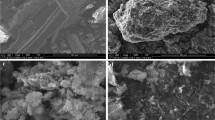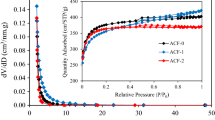Abstract
Three kinds of method were employed to prepare Fe loaded activated carbon (Fe-AC), liquid reduction method, carbonthermal method, incipient wetness method, respectively. Before and after adsorption, the adsorption property of Fe-AC had been analysed. Results indicated that the removal mechanisms were mainly redox reaction, adsorption and precipitation. In addition, the adsorption models fitted with the kinetic model and adsorption isotherm model. Based on the analysis of six influencing factors, we obtain some actual information to deal with the humic acid and the “back to acid”.










Similar content being viewed by others
References
Li XL, Song Q, Liu BJ (2011) Adsorption of uranium by carbon materials from aqueous solutions. Prog Chem 23(7):1446–1453
Bransfield SJ, Cwiertny DM, Roberts AL (2006) Influence of copper loading and surface coverage on the reactivity of granular iron toward 1,1,1-trichloroethane. Environ Sci Technol 40(5):1485–1490
Zhang W, Zuo J, Han XL (2013) Removal of trichlorethylene (TCE) in water by GAC/ZVI/Pd processes. Water Pure Technol 32(1):67–73
Tseng HH, Su JG, Liang C (2011) Synthesis of granular activated carbon/zero valent iron composites for simultaneous adsorption/dechlorination of trichloroethylene. J Hazard Mater 192(2):500–506
Kakavandi B, Kalantary RR, Farzadkia M (2014) Enhanced chromium(VI) removal using activated carbon modified by zero valent iron and silver bimetallic nanoparticles. Iran J Environ Health 12(1):1–10
Wang CB, Li XY, Liu YB, Gao GZ (2014) Study on removal of Pb(II)-210 from aqueous solution by coated nanoscale zero-valent iron. J Radiat Res Radiat Process 32(3):56–60
Crane RA, Scott T (2014) The Removal of uranium onto carbon-supported nanoscale zero-valent iron particles. J Nat Prod 16(12):1–13
Hu S, Yao H, Wang K (2015) Intensify removal of nitrobenzene from aqueous solution using nano-zero valent iron/granular activated carbon composite as fenton-like catalyst. Water Air Soil Pollut 226(5):1–13
Zhang H, ** Z, Lu H (2006) Synthesis of nanoscale zero-valent iron supported on exfoliated graphite for removal of nitrate. Trans Nonferrous Met Soc China 16:s345–s349
Zhan J, Zheng T, Piringer G (2008) Transport characteristics of nanoscale functional zerovalent iron/silica composites for in situ remediation of trichloroethylene. Environ Sci Technol 42(23):8871–8876
Ponder SM, Darab JG, Bucher J (2001) Surface chemistry and electrochemistry of supported zerovalent iron nanoparticles in the remediation of aqueous metal contaminants. Chem Mater 13(2):479–486
Kim H, Hong HJ, Jung J (2010) Degradation of trichloroethylene (TCE) by nanoscale zero-valent iron (nZVI) immobilized in alginate bead. J Hazard Mater 176(1):1038–1043
Yan XX, Liu TY, Wang ZL (2014) Removing Cd(II)from water by nanoscale zero-valent iron entrapped in chitosan beads. J Tian** Normal Univ 34(3):42–46
Xu J, Li Y, **g C (2014) Removal of uranium from aqueous solution using montmorillonite-supported nanoscale zero-valent iron. J Radioanal Nucl Chem 299(1):329–336
De León MA, Sergio M, Bussi J (2015) Application of a montmorillonite clay modified with iron in photo-fenton process: comparison with goethite and nZVI. Environ Sci Pollut Res Int 22(2):864–869
Kim SA, Kamala-Kannan S, Lee KJ (2013) Removal of Pb(II) from aqueous solution by a zeolite–nanoscale zero-valent iron composite. Chem Eng J 217:54–60
Foo KY, Hameed BH (2012) Potential of activated carbon adsorption processes for the remediation of nuclear effluents: a recent literature. Desalin Water Treat 41(1/3):72–78
Liu N (2013) Feasibility studies of GAC/Fe for removing the CAHs in groundwater. J East China Univ Sci Technol 11:26–27
Choi H, Al-Abed SR, Agarwal S (2008) Synthesis of reactive nano-Fe/Pd bimetallic system impregnated activated carbon for the simultaneous adsorption and dechlorination of PCBs. Chem Mater 20(11):3649–3655
Magalhães F, Pereira MC, Fabris JD (2009) Novel highly reactive and regenerable carbon/iron composites prepared from tar and hematite for the reduction of Cr(VI) contaminant. J Hazard Mater 165(1–3):1016–1022
Wang Q, Snyder S, Kim J (2009) Aqueous ethanol modified nanoscale zerovalent iron in bromate reduction: synthesis, characterization, and reactivity. Environ Sci Technol 43(9):3292–3299
Wu LM, Lv GC, Liao LB (2012) Study on removal of chromium(VI) from waste-water by nano-zerovalent iron activated carbon. Acta Miner Sin S1:181–182
**ao J (2013) Research on the preparation of iron-coated activated carbon adsorption and adsorption mechanisms of arsenic. **angtan Univ 37–38
Zhang XM, Chen WF, Yan CC (2015) Comparative study on synthesis of nano zero-valent iron/activated carbon produced by liquid reduction and carbonthermal treatment. J Water Res Water Eng 26(3):129–135
Mondal P, Majumder CB, Mohenty B (2008) Effects of adsorption dose, its particle size and initial arsenic concentration on the removal of arsenic, iron and manganese from simulated ground water by Fe3+ impregnated activated carbon. J Hazard Mater 150(3):695–702
Xu JL (2014) Removal of uranium from aqueous solution using montmorillonite-supported zero-valent iron nanoparticles. China Univ Geosci
Caccin M, Giacobbo F, Da Ros M (2013) Adsorption of uranium, cesium and strontium onto coconut shell activated carbon. J Radioanal Nucl Chem 297:9–18
Li XY, Liu YB, Zhang M (2014) Reduction kinetics of U(VI) in aqueous solution by nanoscale zero-valent iron. At Energy Sci Technol 48(1):7–13
Acknowledgements
This work was financially supported by the National Natural Science Fund Program (11375043), the Main Academic and Technology Leader Funding Program of Jiangxi Province (20172BCB22020).
Author information
Authors and Affiliations
Corresponding author
Rights and permissions
About this article
Cite this article
Liu, Z., Yu, J., Yang, L. et al. Preparation of Fe-loaded activated carbon and its adsorption property of U(VI) in aqueous solution. J Radioanal Nucl Chem 317, 1223–1233 (2018). https://doi.org/10.1007/s10967-018-6037-4
Received:
Published:
Issue Date:
DOI: https://doi.org/10.1007/s10967-018-6037-4




